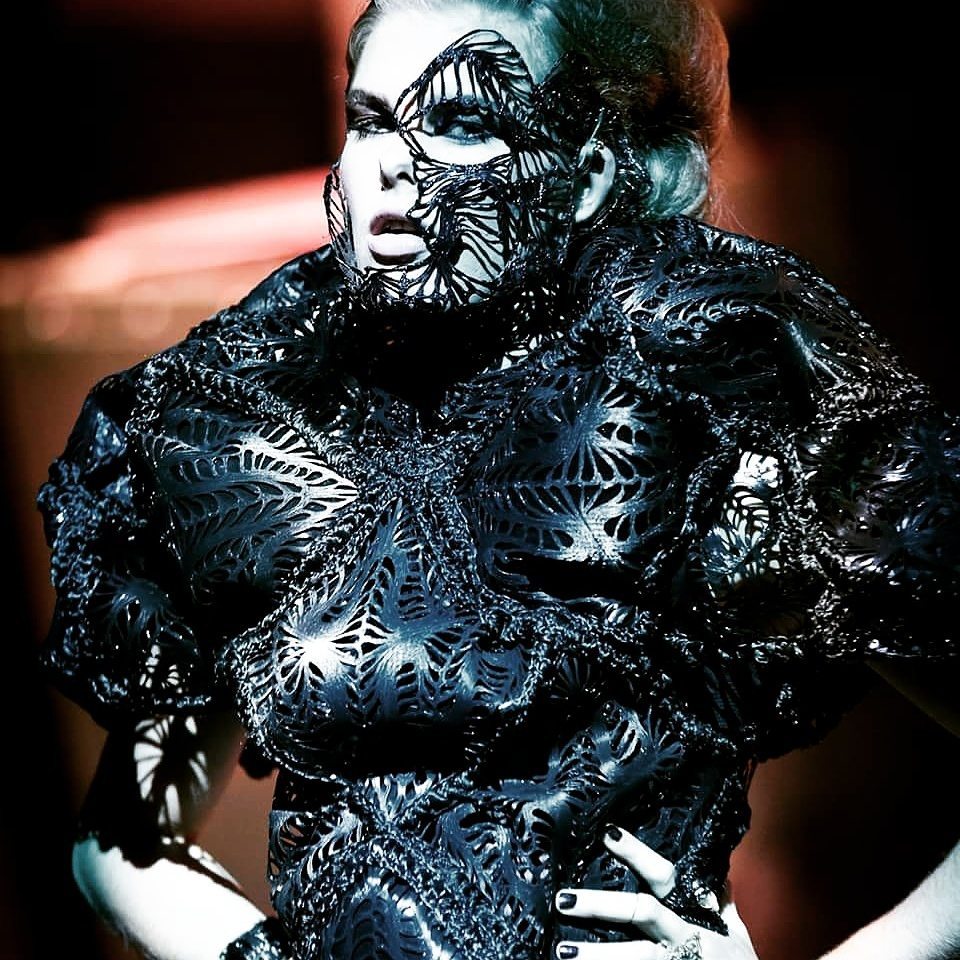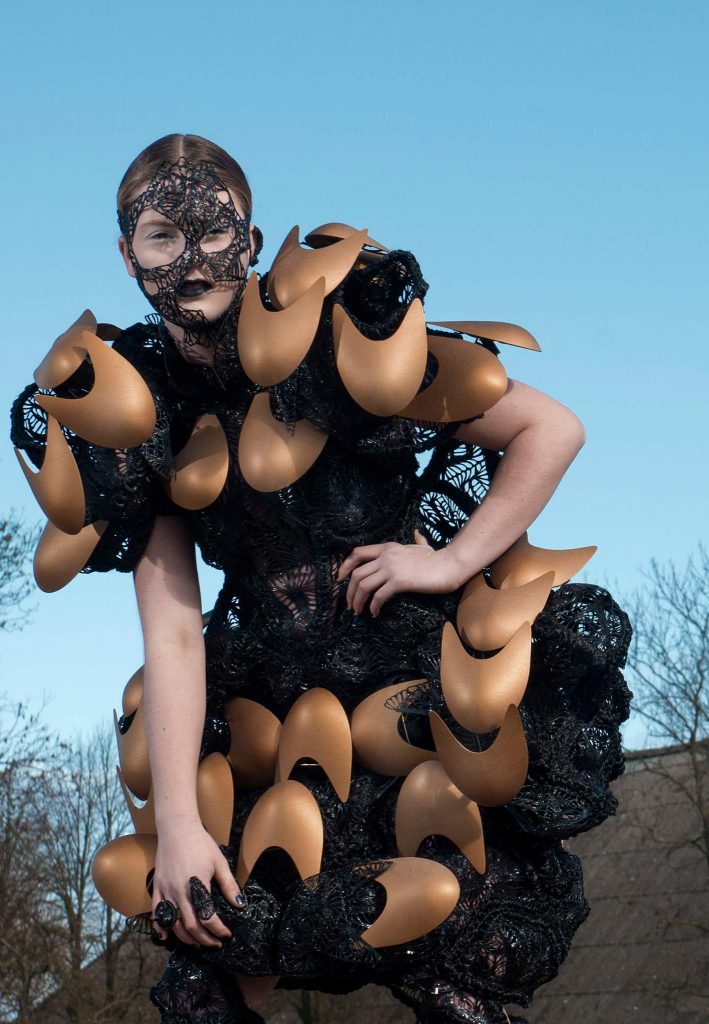Dutch fashion designer Maartje Dijkstra has never been afraid of the Avant Garde. This forward thinking fashion designer specializes in conceptual fashion that brings together influences from the world of electronic dance music, her time working for Alexander McQueen and now a 150-year-old traditional Dutch Groningen costume.
Her ‘Braindrain’ dress has caused quite a stir in the fashion and 3D printing world by bringing the traditional Dutch costume kicking and screaming into the modern age. There are elements of insect exoskeleton, the dress reacts to music and it isn’t exactly practical. As a concept, though, it is spectacular.
She has embraced 3D printing to create extravagant touches and details that mark her work apart and now the designer talks to 3DPringintIndustry.com about her work, her inspiration and how 3D printing provides an opportunity for designers like herself.
1. Can you give us a little about your background and how you came to design this magnificent piece of high fashion?
I’m a Dutch fashion designer based in Rotterdam. I studied at the ARTEZ/HKA Arnhem The Netherlands, where I graduated as a Bachelor in Fashion Design in 2006. In 2005 I did an internship at the company of Alexander McQueen in London, where my interest in high fashion developed.
In 2007 I started my own high fashion label. Now I design and create individual, sculptural, progressive, hand-crafted fashion collections, accessories and fashion/tech pieces.
2. Do you ever step into the realm of the functional? Or do you always work with high concepts?
I always designed sculptural pieces, because I like to manipulate the shape of a body. For me fashion does not necessary needs to be flattering or beautifully for the wearer, but it has to be interesting to the audience.
Also, as a fashion designer you can tell your story in the most extreme form on the runway with music, models and lights. As a clothing designer you have more rules to follow like wear-ability, practicality, trends etc.
3. Which works do you think best embody your spirit as a designer?
The work that embodies the spired of my work is, of course, the Braindrain piece. Also my piece, Hard Core Vein 2.0, because of the complexity and challenge in 3D printing. My latest design, Surface Distortion 2016, embodies my work as well.
The bombastic fashion/ technology piece is focused on an all-encompassing experience in which fashion, technology, lights, music and architecture merge together. Upon closer inspection, the outfit’s manual 3D printed patterns and layers become apparent.
When you zoom out, you realize the work responds to the music by producer Newk (NL) and its surrounding lights by designer Co2RO (NL).
4. You say the Groningen costume of 1850 was the start point, what does that mean to you personally? Is it a family connection for you? How significant is it?
I was asked to design a fashion/ technology piece specially for an exhibition in Leens, a village near Groningen, where 15 pieces of my previous collections and the old Groninger costumes where combines together. Their idea is to show the past and future in fashion.
I grew up in this village, and they have a big collection of costume history in this area, but it was a one-time jump into the past.
It was very unusual for me because I never look back in time, I only look forward and design with the future in mind. It was nice and interesting to see how future forward they were in this period of industrialization. I was especially drawn to the ‘gold head piece’ named the ‘Ear iron’ or in my own words the ‘golden skull’. That gave me the inspiration to create Braindrain.
I’m not very fond of historic costumes if I look at the fabrics of this period, but the accessories were amazing. That is why I took the ear iron as inspiration for the 3D printed golden parts of Braindrain.
5. High tech is a regular feature in your work, what does it mean to you?
I was always interested in the future, dark electronic music and the complexity of nature/science. I already started designing pieces that where inspired by this when I studied fashion. This was especially true in the way I used or made the fabrics and the sculptural and animal- like silhouettes I used.
I started to integrate technology literally with the Intimacy white dress, I designed for Studio Roosegaarde in 2009. After that I designed the following fashion tech piece, Denzipfaden 2012, Obstruction 2012, Hard Core Vein 1.0 and 2,0, 2014, Chitin Noise that will be shown later this year, Braindrain 2016, and Surface Distortion 2016. I launched this piece on the 3th of June.

6. Is this the first time you’ve employed a 3D printer in your work?
No, the first time I used 3D printing was with the Hard Core Vein 2.0 piece in 2014/15. Next to my work as a fashion designer I draw imaginative illustrations. This became a signature of my brand, combining these two techniques.
For the Hard Core Vein project, I drew a skull with 2 birds in black lines on paper (2D). After that I made a 3D version of it, literally by hand, and 3D printed the hollow and transparent piece. Then I filled them with dark ink that moved to the beat of the music, like blood trough the veins during a heartbeat. It was a very complex and almost impossible project, but it worked. So I will print a new 3.0 version this year.
7. Have you enjoyed the experience and did you really need to learn a lot to get to work or was it quite intuitive and a natural part of the process?
I like 3D printing a lot. But for me it is not something I want to do because it is a trend, especially in the design/fashion industry.
I think you should use it for things you could not create otherwise, like this Hard Core Vein piece I designed. I could only make this because of 3D printing.
It sounds bad but I’m not technical at all. I always co-operated with music producers, programmers, 3D printing companies or experts in this field with fashion technology projects. I believe in good co-operations, so everyone does what they do best and come up with the best solutions because of different creative minds or approaches.
I have watched some parts being 3D printed but for me it’s is very frustrating to see because the printer does my job 🙂
I’m a fashion designer that makes and designs everything myself, and use a massive amount of handwork/embroidery. So it is not natural for me to see this machine doing my work. But it is great to know what is possible and to combine my hand stitching techniques with 3D printed parts. So it becomes unique again and shows my own individuality as a designer.
8. How much faster has it made your work? Did it give you the chance to experiment with things you might not have done if it hadn’t been available?
It is how you look at it. I would never 3D print a total dress. I would always use embroidery together with the 3D printing parts. Hand-stitching is more time-consuming then printing, but I would never give this up to a machine. That’s why I became a fashion designer.
What I like about 3D printing is making clean and complex looking parts, that cannot be made otherwise. So there always needs to be a complex challenge when I want to 3D print, otherwise for me it is unnecessary.
What makes 3D printing amazing is that you can design whatever you want, there are hardly any boundaries of what is possible. The only concern for me is that I hope 3D printing companies will be more open for the experimental side of 3D printing, together with designers, because it is hard to find companies who are willing.
I think it is important for the industry but also for designers to merge the companies with the creative designers. We have different approaches, which can result in faster progress.
9. Did it help you reduce costs as a result of the time saving?
3D printing is still expensive if you look at my profession. I usually need a lot of parts to create a dress/piece or I have the most complex idea that needs a special material/filament or complex machine to print. So this comes with a price tag.
8. Has it given you new ideas that maybe couldn’t be achieved any other way on this dress?
Without 3D printing it would not be possible to create the golden parts, that were the most important and elements of the design. The golden parts, that are printed by Oceanz beautifully, have nice details like perfect holders for the many LED lights and motors inside. They were printed in one piece, and contain a complex line detail (a part of my hand drawn illustrations ) that you can only notice when the LEDS turn on.
This effect is possible because they are printed in different thickness of Nylon, so some parts are semi-transparent. You will only see the lines in some parts of the golden element. The golden parts are also programmed to react to the electronic music, so this also gives it an extra dimension.
10. Will it be a regular fixture in your work?
Yes, definitely! I will turn to 3D printing in the near future as my designs become more complex. Because of the extreme fast development in technology, there is so much more space to design more bombastic and progressive fashion pieces. And like I said, I’m future focused. So this development is amazing and inspirational to me and connects with the way my creative mind works.
11. Can you give us any ideas about how you will use 3D printing in your work in the future?
I will use 3D printing as a tool for details and elements in my work I cannot produce otherwise, and also to work with great companies or experts that are still open for experiment that will lead to many more great things.




